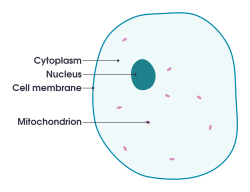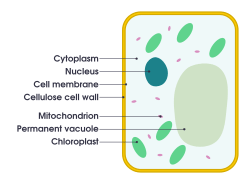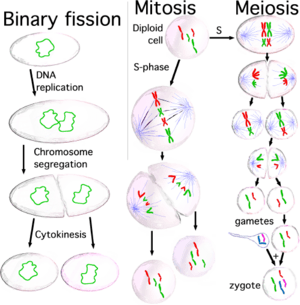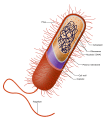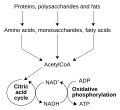Cell facts for kids
Quick facts for kids Cell |
|
|---|---|
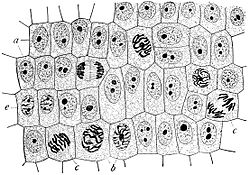 |
|
| Onion (Allium cepa) root cells in different phases of the cell cycle (drawn by E. B. Wilson, 1900) | |
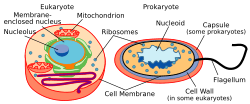 |
|
| A eukaryotic cell (left) and prokaryotic cell (right) |
Imagine tiny building blocks that make up all living things! In biology, a cell is the smallest basic unit of life. Every living thing, from a tiny bacteria to a giant whale, is made of cells. And guess what? New cells are always made from old cells dividing.
Each cell has a special outer layer called the cell membrane. This membrane separates the inside of the cell (called the cytoplasm) from the outside world. Inside some cells, you'll find tiny parts called organelles. Think of them like tiny organs that each do a specific job. For example, the nucleus holds the cell's DNA, and mitochondria create chemical energy for the cell to use.
Contents
What Are the Main Kinds of Cells?
There are two main types of cells: prokaryotic cells and eukaryotic cells.
- Prokaryotic cells are simple cells. They do not have a cell nucleus or many other organelles. Bacteria and archaea are examples of prokaryotes. They do have special tiny compartments inside them.
- Eukaryotic cells are more complex. They have a cell nucleus and many different organelles. Eukaryotic cells are much larger than prokaryotic cells. They can be up to 1000 times bigger! Eukaryotes keep their genetic information (DNA) on chromosomes inside their cell nucleus. All living things made of more than one cell are eukaryotes.
What Are Prokaryotic Organisms?
Today, the only prokaryotic organisms are bacteria and archaea. These simple life forms appeared on Earth before eukaryotic organisms. For a long time, only prokaryotes existed!
There are also viruses, which are a bit tricky to classify. Viruses are made of RNA or DNA, and protein. They can only reproduce by taking over the cells of bacteria or eukaryotes. Viruses can cause important diseases.
What Are Eukaryotic Organisms?
Eukaryotic organisms can be either single-celled or made of many cells.
Single-Celled Eukaryotes

Unicellular organisms are living things made up of just one cell. Some examples are:
Even though they are tiny, single-celled organisms need to do many things to survive:
- They need to eat to get energy.
- They need to respire, which means using oxygen to turn sugar into energy.
- They must get rid of waste.
- They must reproduce to make more of themselves.
- They must grow.
Some single-celled organisms can also:
- Move around.
- Sense what is happening in their environment.
- Get their energy from the sun, like cyanobacteria.
- Use fermentation to get energy, like yeasts.
- Use anaerobic respiration (without oxygen), like Clostridium botulinum.
Multi-Celled Eukaryotes
Multicellular organisms are made from many cells working together. These can be organisms with just a few cells, or ones with millions or even trillions of cells! All plants and animals are multicellular organisms.
The cells in a multicellular organism are not all the same. They have different shapes and sizes. They also do different jobs. This is called being specialized. For example, a muscle cell is different from a skin cell. Because they are specialized, these cells cannot live alone. They need other cells to do the other jobs needed for the organism to survive. They live together as a team!
Cell History: Who Discovered Cells?
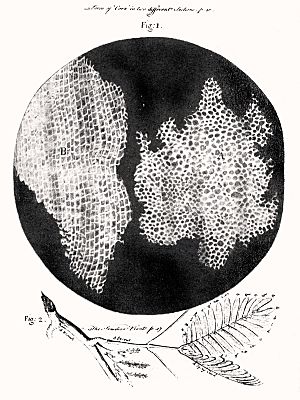
Cells were first seen by Robert Hooke (1635–1703). In 1660, he used a special microscope with two lenses. He looked at thin slices of cork, leaves, and some insects. He wrote about his discoveries in his book Micrographica in 1665.
Hooke called them "cells" because they reminded him of the small rooms (called cella) where monks lived.
After Hooke, many other naturalists and philosophers used microscopes. Scientists like Nehemiah Grew (1641–1712) and Marcello Malpighi (1628–1694) studied the structure of plants.
Later, Antonie van Leeuwenhoek (1632–1723) made amazing discoveries. He drew tiny "animalcules" (little animals) that he saw through his microscope. This opened up a whole new world of tiny microorganisms, like Protozoa.
The idea that cells are the basic building blocks of all life slowly grew. In the 1830s, Theodor Schwann (1810–1882) and Matthias Schleiden (1804–1881) are often given credit for the cell theory.
The cell theory has three main ideas:
- All living things are made of cells.
- The cell is the basic unit of structure and how things work in all organisms.
- Every cell comes from another cell that lived before it.
Cell Reproduction and Life Cycle
Cells need to make copies of themselves to grow, repair, and reproduce.
- Prokaryotic cells reproduce using a simple process called binary fission. This is where one cell simply splits into two identical new cells.
- Eukaryotic cells have more complex ways of dividing.
- Body cells (like skin or muscle cells) divide by mitosis. This process makes two new cells that are exact copies of the original cell.
- Special sex cells (involved in sexual reproduction) are made by a process called meiosis. This process creates cells with half the usual number of chromosomes.
For both binary fission and mitosis, the cell must first make a perfect copy of all its genetic information (DNA). This way, each new cell gets a complete set of instructions.
Related pages
Images for kids
-
Structure of a typical prokaryotic cell
-
Human cancer cells, specifically HeLa cells, with DNA stained blue. The central and rightmost cell are in interphase, so their DNA is spread out and the entire nuclei are colored. The cell on the left is going through mitosis and its chromosomes have become tightly packed.
-
An outline of how proteins, carbohydrates, and fats are broken down (catabolism)
-
An overview of protein synthesis. Inside the nucleus (light blue), genes (DNA, dark blue) are copied into RNA. This RNA is then changed and controlled, becoming a mature mRNA (red). The mRNA then moves out of the nucleus into the cytoplasm (peach). Here, ribosomes (purple) read the mRNA to build a protein. Ribosomes match the three-base codons of the mRNA to the three-base anti-codons of the correct tRNA. New proteins (black) are often changed further, like by attaching to another molecule (orange), to become fully active.
-
Staining of a Caenorhabditis elegans which shows the nuclei of its cells.
-
Stromatolites are left behind by cyanobacteria, also called blue-green algae. They are the oldest known fossils of life on Earth. This one-billion-year-old fossil is from Glacier National Park in the United States.


